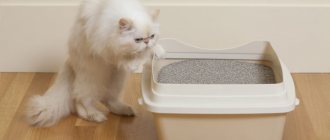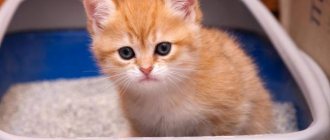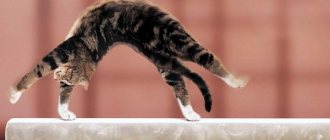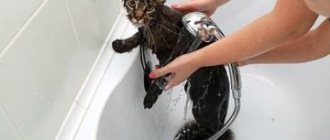Reasons for ignoring the tray
There are many reasons and situations when a cat ignores the litter box. To solve the problem, you need to find out what is the reason for this pet’s behavior. Why did the cat stop going to the litter box and how to fix the situation? – The answers are given below.
Cat in the litter box
Tray and filler
Nowadays you can buy various types of fillers in pet stores - wood, mineral, corn, etc. The choice must be approached carefully. One of the possible reasons why a kitten does not go to the litter box is an incorrectly selected litter. The pet is experiencing discomfort. Mustaches sense foreign odors. Cats prefer fine-grained litter, similar in consistency to sand. It is best to use unscented, as extraneous scents repel cats.
You can experiment with different options. The cat's litter box should be washed without using scented products. Flavorings will confuse the animal and can cause allergic reactions, which will then have to be treated.
Fillers
Wrong place chosen
After the pet appears in the home, it is necessary to determine the place where the tray with the filler will be placed. It is better to choose a quiet, unlit place for the toilet. The cat needs privacy to relieve itself. He does not like noise that will distract him. Cats require silence to concentrate. Do not place the tray near noisy appliances. It will be much more convenient for the cat to relieve himself in a secluded, unlit place. If a kitten or adult animal does not go into the litter box, then you should try moving it to another place.
Psychological problems
A pet may ignore the litter box due to various psychological problems.
Moving to a new place of residence can lead to stress in a cat. They get used to one place and have a hard time moving. The pet needs time to get used to the new environment. There is no need to yell at him if he went to the toilet in a place not intended for this. Screaming and swearing will complicate the situation.
Important! When a pet goes on a spree, it experiences a complex psycho-emotional state. He begins to mark the territory in which he lives. This behavior can be perfectly changed using special drops and tinctures. In this case, sterilization and castration will help.
Cats may feel jealous when a new pet arrives in the house. Because of jealousy, cats may change their behavior and stop going to the litter box, demonstratively showing this to the owner. The cat is worried, so you need to show it that it is loved. If there are several pets in the house, then there should be the same number of trays.
A cat's bad associations may also be the reason why he avoids the litter box. Perhaps while the cat was in the litter box, something scared her. They remember these moments because they experienced fear. It’s worth trying to move the tray to a different place, away from the previous one.
Psychological problems
Health problems
The cat may ignore the tray for health reasons and jump out of the tray. Among the main diseases are those listed below.
Inflammatory process and infections. Cystitis or other infectious diseases cause frequent urination in cats. Due to frequent urges, the cat cannot always make it to the toilet in time and pees wherever it has to.
Diabetes mellitus, kidney disease, and inflammation of the urethra cause a constant desire to drink. If your cat drinks a lot of liquid, you need to sound an alarm. Such diseases need to be treated urgently. These diseases cause frequent urination.
Pain during urination. Many diseases cause pain when urinating. Perhaps this causes the cat to have unpleasant memories of the litter box, and therefore she begins to avoid it.
Urolithiasis disease. Pets feel severe pain when urinating, and in severe cases, urine is not released and the cat experiences pain. Sometimes when a cat is sick, it constantly lies down and stops going to the toilet, experiencing discomfort.
When a cat doesn’t go to the litter box “for the most part,” the food may have been chosen incorrectly. You can try giving laxative food or medicine.
To rule out health problems, you need to be examined by a veterinarian. If your pet is diagnosed with an infection or disease, a specialist will prescribe treatment.
The cat is sick
Other options
A pet may refuse to use the litter tray for other reasons. Some pets hide in secluded places after taking a bath to dry their fur and calm down from the stress they have experienced. Fearing water, they may go to the toilet behind the sofa and in other places. Trimming nails can also be a cause of litter box neglect. After trimming, the claws become sensitive and the cat experiences discomfort when digging. To make your cat comfortable, you need to change the litter.
Why does a cat shit in the wrong place?
There's always a reason why your pet stops using the litter box, and it's not to make you angry. Take a close look at what's going on in your cat's world. You must uncover the source of the problem and fix it. Causes are medical or behavioral factors.
Medical problems
If your cat makes puddles outside of the litter box or is unable to relieve himself and nervously licks his genitals, take him to the vet immediately. This may be a sign of a urinary tract infection or blockage from kidney stones.
They cause severe pain when urinating, forcing the pet to avoid the litter box - the culprit of suffering in his understanding. Some cats will even urinate and cry in front of you or go to the bath to let you know something is wrong.
A pet whose urinary tract is blocked may die within hours or suffer permanent organ damage from the buildup of toxins in the body.
Other diseases that force a cat to shit in the wrong place:
- metabolic disorders such as diabetes and kidney disease increase the amount of urine produced, and the sick animal does not have time to get to its toilet in time;
- interstitial cystitis (inflammation of the bladder);
- a cat with arthritis may have problems walking up stairs or climbing into a high-sided litter box;
- defecation disorders (constipation or diarrhea), painful for the cat, can cause it to avoid its toilet due to unpleasant associations;
- Dementia in older animals can cause them to forget where the litter box is or even how to use it correctly.
Behavioral reasons
If the presence of diseases is ruled out by the veterinarian, continue to look for the factor that causes your pet to present unpleasant “surprises”. Most cats have no problem using the litter box.
About 10% of furry domestic predators are so picky that they find a lot of reasons (known only to them) to decide that their toilet is an unpleasant place to defecate.
14 common reasons why a cat shits in the wrong place:
- the tray is not clean enough - you haven’t changed the filler for a long time or you haven’t washed the tray with the mesh well;
- the cat doesn’t like her “potty” - it’s uncomfortable/cramped, too big/small or low/high, and so on;
- she doesn’t like the consistency of the filler or the location of the tray;
- the cat shits in the wrong place because it was frightened by the attack of another pet in the process of relieving itself;
- inconvenient location of the tray, which does not allow privacy or prevents “evacuation”;
- There are not enough litter boxes for all the cats in the house;
- something has changed in the cat’s usual way of life - he is alarmed, marking his territory in order to calm down or assert himself;
- the cat shits in the wrong place because it associates the litter box with punishment or a painful condition;
- conflict with another pet;
- the depth of the filler is too deep - cats usually prefer two to five centimeters of substrate;
- a new preference for relieving on certain surfaces or textures, such as carpet, planter soil, or bedding;
- sexual heat in cats - they mark objects in the house with urine to attract a female;
- stress due to moving, boredom, poor living conditions, violence, the arrival or departure of other pets;
- a cat poops in the wrong place because it is too young, too old or sick to get to its litter box in time.
Retraining Tips
Repeated training to the tray is required after moving or when an adult animal appears in the house.
How to toilet train a kitten: options for making it go to the litter box
It is necessary to monitor the cat's behavior, and when he wants to go to the toilet, he needs to be caught at that moment and taken to the cat litter box. The main thing is not to scare him and calmly show him that this is the place where he needs to go to the toilet. The procedure will have to be repeated several times.
If the cat sniffed the tray and did not go into it, then the tray and filler need to be replaced. Perhaps he was put off by the smell of plastic and the aromas of the filler. Another option is that the tray is not the right size, and it cannot go where it is needed.
Important! You can try moving the tray to the place that the cat has chosen.
When an animal is brought from the street, it is much more difficult to train it to the litter box, because previously you could go to the toilet wherever you wanted. As a temporary measure, you can try bringing some sand from outside. The cat smells a familiar smell and probably goes to the toilet.
With effort and patience, you can teach and instill the skill of going to the toilet in a tray. Some cat breeds, such as British cats, are difficult to train to the litter box, and it may take time - a month or even more.
Tray training
Causes of urinary problems
If a cat sits on the tray for a long time, but the litter remains dry, what can provoke this condition in the animal?
The reasons may be:
- insufficient consumption of clean water . For this reason, a high percentage of salts is formed in the urine, which provokes the formation of stones. Urolithiasis develops;
- heredity . If a cat has a history of diseases of the genitourinary system, then the likelihood of developing pathology increases significantly;
- physiology . Sometimes difficulties with urination are found in small kittens. They may be born with pathologies of the urinary tract. Treatment of the disease is only possible through surgery;
- incorrectly composed diet . In this case, the cat sits on the tray to no avail - he cannot pee in any way - because his diet is unbalanced. Problems in cats arise if the daily diet includes too much fresh meat and fish, as well as salty and mineral-containing foods;
- excess weight . An overfed pet moves little, which can cause difficulties with the outflow of urine. The litter in the tray can also remain dry;
- stressful situation . Severe stress experienced can also provoke urinary retention.
The cat sits on the tray for a long time, but never leaves - what diseases can provoke urinary retention? This:
- urolithiasis. Develops as a result of improperly organized nutrition;
- cystitis of various origins - viral or bacterial. The disease is an inflammation of the bladder. The cause may be either simple hypothermia or bacteria entering the animal’s body;
- pathologies of the renal system. The reason why a cat often sits on a tray for a long time, but is unable to urinate, may be pyelonephritis, nephritis, nephrosclerosis, stones, etc.;
- colds and viral diseases;
- atony of the bladder. Can develop as a result of injury, rupture of the organ wall;
- anuria. A state of severe dehydration;
- spinal cord injuries;
- neoplasms (malignant and benign).
It is important to remember the following: if the cat sits on the tray for a very long time, but the litter remains dry, the animal has become timid and tries to hide, or has a fever, then the pet must be urgently taken to the veterinary clinic.
Remove tag odor
When do kittens start going to the toilet on their own?
Many pet owners face a serious problem - the appearance of odor from cat marks. The cause of the unpleasant odor lies in the composition of the urine:
- urochrome stains urine;
- urea makes urine sticky (when the mark area dries);
- uric acid crystallizes in cat urine and these crystals do not dissolve in water, so it is difficult to remove.
If you wash the mark area with plain water, the smell will still remain. Even if you don’t feel it, it will appear again in just a couple of days, as it has become deeply ingrained into the surface.
It is difficult to remove odor from a surface that absorbs moisture well.
Today, there are many methods for getting rid of the smell left by cats.
Folk remedies
When an adult cat or a small kitten begins to shit, it is necessary to correct the situation. With the help of folk remedies, you can quite successfully get rid of cat marks. It is not difficult to remove marks from hard surfaces. Even plain water mixed with a special product can do the job just fine. But if the cat left marks on upholstered furniture, you will have to work hard.
When removing cat tags, you must wear rubber gloves. You need to start cleaning the area right away. If you start cleaning in time, the uric acid will not have time to crystallize. When time is lost, it is almost impossible to clean without chemicals.
How to cleanse using folk remedies:
- vodka or alcohol effectively destroys organic molecules that cause odor. Alcohol is able to penetrate deeply into the tissue;
- Vinegar is an excellent mark remover. It is diluted with water in a ratio of 3:1 and the required area is wiped with a moistened sponge. The smell of vinegar dissipates over time;
- baking soda. It is mixed with vinegar. First, the mark area is generously sprinkled with soda, and then vinegar is poured. A chemical reaction occurs and the smelly, organic components disappear. This method must be used carefully, and it is not suitable for all surfaces.
Cleaning tags with folk remedies
Great for fighting cat marks:
- hydrogen peroxide;
- iodine diluted with water;
- strong brew;
- potassium permanganate.
Important! Ammonia cannot be used. The ammonia contained in ammonia can attract your pet.
kitten playing in the tray
Well, our saga with “kitten breeding” has ended.
All kittens found their owners. In our opinion, they are more than worthy. (They send us photographs periodically, and judging by the questions and stories, they feed, love and care much more than we could even imagine 
4 kittens left quite quickly and early...at 1.5 months.
I started sending out photos and sale announcements among my friends in advance.
1. A single man took in a white boy (they didn’t ask where his wife was, but he has grown-up independent children). Tall, calm, mustachioed. Named Gray.
Tall, calm, mustachioed. Named Gray.
2. Then, quite quickly, a white girl was taken away - a family with three children. They called it Lucky.
(the only owners who raise doubts... Literally on the way out, holding the kitten under his jacket, the man said that they had a cat... gave birth to kittens, and then scratched their baby (most likely protecting the kittens)... Dad was terribly angry... wanted " throw it out"...but the children begged...and then, magically, the domestic cat “disappeared from the house.” “Where did it go? They didn’t seem to open the door, it couldn’t run away...” Dad was perplexed... I really want to believe that it was so... and not Thus the Pope took out his anger.
But their Mom sends me photographs, she is touched... and outwardly everything is quite fine. I hope that she won’t be thrown out later - for some kind of prank or scratches 
3. The white boy was taken in by a young colleague of my Husband. Sends us a video... our baby is playing The only owner who can’t come up with a name for him
Sends us a video... our baby is playing The only owner who can’t come up with a name for him
4. The spotted girl was taken by her Mom and her adult Son. In appearance and conversation, they are a very positive family, and they are shaking over the kitten, “rubbing meat with cottage cheese” and so on :-). They live together. Our cat chose him as her owner 
5. The second spotted girl was taken by a girl I knew who cut, colored and styled me this New Year. For your Mom. People are also cat lovers and happy. This cat stayed with us the longest... Suddenly all the calls, questions, requests suddenly stopped... we were already starting to worry. But no, she was just waiting for her mistress. They named her Matilda.
For your Mom. People are also cat lovers and happy. This cat stayed with us the longest... Suddenly all the calls, questions, requests suddenly stopped... we were already starting to worry. But no, she was just waiting for her mistress. They named her Matilda.
One single spotted kitten Boy and Girl of unusual British colors - tabby Chipmunk - were “booked” a month ago. But one mistress was away, and the owner was on watch.
6. Two days ago the boy was taken away. The hosts are wonderful. People are wealthy, and they really love cats (they recently lost their own from old age) - it’s obvious from everything - how much they are touched by the cat and dote on him... They named him Barsik (although before meeting him his name was Baksik :-))
There is only one Chipmunk left. The owner is coming this weekend and will take her to St. Petersburg.
The owner is coming this weekend and will take her to St. Petersburg.
7. Young couple, with Son. Our acquaintances. They can't wait for the cat. Dad is a great cat lover and Mom is a dog lover, and says that for the first time she liked and wanted a cat so much.
Our acquaintances. They can't wait for the cat. Dad is a great cat lover and Mom is a dog lover, and says that for the first time she liked and wanted a cat so much. Moreover, at school she had a “nickname” Chipmunk for many years... and she took this as a plus as a sign
Moreover, at school she had a “nickname” Chipmunk for many years... and she took this as a plus as a sign











